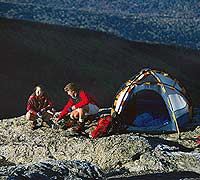For many, camp cooking is a messy, disheartening, ultimately bland affair. But it doesn’t have to be. Take, for instance, the following gastronomical field trip, led by three of the nation’s finest chefs, maestros of the kitchen who—surprise!—are also no strangers to the demands of wielding a skillet in the outback. So get out the travel toque and tell your campmates to step aside: An artist is at work.
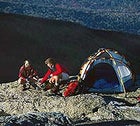
You’re Only as Good as Your Preparation
All the logisitics, equipment, techniques, and shortcuts you’ll need to become a campground superchef.
While we camp cooks are often content to let our gastrointestinal juices do the planning for us as we wander aimlessly down the supermarket aisle, a true gourmet outing requires serious forethought. Sure, it may seem easy enough to flip through Great Good Food and jot down a list of ingredients. But knowing how the recipes will translate to an outdoor environment, and how to pull them off without having to hump your entire kitchen to the campsite, is a bit more tricky. Which is why, before turning to the menus offered by our three celebrity chefs, we consulted with a few experts on the fine points of preparation. Claudia Pearson, a rations manager for the National Outdoor Leadership School and coauthor of The NOLS Cookery, Blake Spalding, a river cook with Canyon Explorations in Flagstaff, Arizona, and Carole Latimer, author of the indispensible backpacker’s bible Wilderness Cuisine, share their advice on matters ranging from pre-trip planning to ecologically sound cleanup methods. What follows are the combined pearls of 46 years of backcountry culinary wisdom.
Shop Wisely
First, sift through your menus and compile a complete list of ingredients to purchase. “Go the extra mile and get the freshest meats and vegetables you can find,” advises Spalding. “It’ll make a big difference at the end of a hard day.” But be sure to consider the water supply at your destination before you settle on a final meal plan: If you have to haul in lots of water, you’ll either have to prepare for substantially increased weight or make menu sacrifices to lighten your load. Of course, the time of year should also play a role in determining your final menu. Trekking in July gives you plenty of daylight for leisurely preparation, cooking, and cleanup, while an October trip may mean lights out at 6 p.m. Latimer recommends packing what she calls “bailout food”—freeze-dried dinners or instant noodles, for instance—lest you be caught in a downpour or miscalculate the length of a hike and find yourself forced to peel potatoes in the dark.
Make a Spice Kit
Pack whatever seasonings your recipes call for into one-ounce plastic bottles (most backpacking stores carry a variety of different-size plastic bottles made by Nalgene), and then fill two larger containers with olive oil and butter. Place these and some loose garlic into one stuffsack. “We call this the food repair kit,” says Pearson. “Spices can fix any disaster.”
Pack with Precision
On a three-day weekend camping trip, Pearson recommends packing the ingredients for each meal (except the spices and miscellaneous items such as coffee, tea bags, and butter) into separate stuffsacks. Be sure to label them clearly—”Day One Breakfast,” “Day Three Lunch,” and so forth—so that you can instantly grab the one you need. Next, consider Latimer’s three cardinal rules for packing vegetables: Don’t wash, don’t cut, and don’t wrap in plastic. Adding moisture to a vegetable or exposing its interior hastens the decaying process. “And they need to breathe,” says Latimer. “Just put them in brown paper bags–they’ll last longer.” Pack especially soft items, such as tomatoes and avocados, inside your pot for protection. To save weight and space, repackage all boxed foods, such as pasta, into plastic bags and transfer canned or bottled liquids, such as tomato sauce, into Nalgene bottles.
Consider Your Meats
If you plan to keep the hiking to a minimum—establishing, say, a base camp a few miles in and conducting loop hikes from there—think about bringing along a cooler (see below). But even without a cooler, spoilage shouldn’t pose a problem on a three-day trip as long as you take proper precautions and steer away from poultry. During colder months or in cooler climes, obviously, meat keeps longer. If it’s particularly hot, however, you’ll want to use canned or dried meats on the second and third days. And no matter where you’re camping, don’t expose your pack to direct sunlight.
Carefully plot the order of your meals. You can serve virtually anything the first night if you keep it in a cooler until you reach the trailhead. Meat on the second night should be fine if you hard-freeze it a couple of nights before the trip, double-wrap it in resealable plastic bags, and then pack it in a paper bag insulated with crushed egg cartons and newspaper. Keep it on ice until you get to the trailhead and then store it deep in your pack. Meals on day three should involve only canned or dried meats.
And If You Have More Room…
When river rafting, horsepacking, or car camping, weight and space become less of a concern. If that’s the case, you might want to consider adding the following:
A Cooler Careful management of a hard plastic cooler can prevent food spoilage for up to two weeks. Use block ice, not cubed or crushed, and remove the plastic so the blocks will fuse into one long-lasting chunk. Spalding recommends placing a fitted piece of cardboard between the ice and the food and a piece of fitted foam rubber between the food and the lid for maximum insulation. If possible, open the cooler only when the sun is down, and remember to drain water repeatedly.
A Dutch Oven “They’re infallible for baking,” Spalding says. “They seal in moisture better than my kitchen oven.” Spalding suggests combing thrift shops to find a well-seasoned, cast-iron oven. Make sure it has legs on the bottom and a half-inch lip around the rim to hold coals.
Cooking on an Open Flame
Of course, nothing beats a lightweight camp stove, which not only is more efficient and ecologically sound than a campfire, but also offers the ultimate cooking advantage: flame control. However, a couple of the recipes offered by our chefs do call for fires, and you never know when your fuel canister may come up empty. So as long as fires are allowed where you’re camping, by all means go for it. The best idea is to use an existing fire ring; if there isn’t one at your campsite, think small and low-impact:
First, remove and save the duff from a small area clear of tents and vegetation.
Next, dig a shallow, 24-inch-diameter pit in the exposed mineral soil. Collect downed firewood from a wide area to prevent denuding the campsite.
Keep the fire as small as possible for better flame control.
When breaking camp, finish burning all partially burned wood, crush the coals, and scatter the ashes, leaving your ring intact for future campers.
“The most important thing about cooking over a fire is to never leave the area—not even for one second,” says Pearson. Even with a small, manageable flame, she warns, move your pan or the food on your grill often. Set cooked items on hot rocks near the fire to stay warm, and always use gloves or pot grippers when moving cookware. If you forget your grill, Pearson advises against trying to fashion a spit: “It’s too labor-intensive. Just skewer your meat on a stick or put it in a pan and hold it over the fire.”
Cooking at Altitude
If you’re feeling lucky, you can try cooking thin pastas, such as angel hair, up to about 10,000 feet. But be forewarned: You’ll need lots of water and about five to seven minutes of cooking time. Above 11,000 feet, stick to minute rice or instant couscous. “If you try pasta up there,” says Latimer, “you’ll get wallpaper paste.” Blame it on decreased atmospheric pressure and the fact that water boils at a lower temperature. Take care, also, when baking at altitude. Decrease baking powder and sugar; increase liquid, flour, and cooking time.
Mood Enhancers
If your plan is to modify the four- to six-person adventure our chefs have concocted into an intimate weekend for two, you’ll be able to cut out quite a bit of food weight—which we hope will leave some room in your pack for these ambience accessories, guaranteed to convince someone special that your sleeping bags work better when zipped together:
The silver side of a space blanket, spread as a tablecloth.
Colored bandannas for napkins, arranged in three-point stance.
A centerpiece consisting of a candle lantern encircled by freshly picked wildflowers.
A bottle of 1986 Chateau Latour, which you naturally have been saving for just this moment, served in plastic champagne glasses with screw-on stems.
Cleanup
When you’re done feasting, heat up a pot of dishwater and march at least 200 feet away from any stream or lake to wash your utensils. Unless you’ve brought along biodegradable soap, use one of nature’s scrub brushes—pinecones, sand, or snow—and disperse the dirty dishwater over a wide area when you’re finished. As for the scraps of food you won’t be using as leftovers, the age-old mantra is this: Pack it in, pack it out.
Day One: Innovation Within Reason
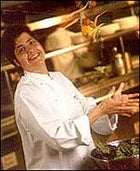
Seattle legend-in-the-making Monique Barbeau looks to expand the boundaries of trailworthy cuisine
One of the reigning queens of the current Northwestern culinary scene is Monique Barbeau, head chef of Seattle’s acclaimed Fullers restaurant. “I just try to be innovative without going over the edge,” says the 31-year-old French Canadian, whose award-winning creations capitalize on her region’s bountiful palette of salmon, shellfish, mushrooms, and berries. When she’s not creating new masterpieces or globe-hopping for ideas, Barbeau helps plan recipes for her sister’s Vancouver-based adventure travel company—adhering, always, to the same artful logic she employs at Fullers: fresh, local ingredients with a generous splash of imagination. “These dishes can be considered gourmet,” she says, “but they’re also quite easy to do on the trail.”
Breakfast: Crunchy Nutty Granola
1/4 cup canola oil
1 cup maple syrup
1/4 cup honey
1 vanilla bean, split and scraped
1-1/2 tsp. cinnamon
2 tsp. cardamom
1 tbs. orange peel
2 cups oatmeal
1 cup wheat germ
1/4 cup unsweetened flaked coconut
1/2 cup hazelnuts, toasted, skinned, and roughly chopped
1/2 cup pumpkin seed
1/2 cup slivered almonds
1/2 cup chopped dried apples
1 cup raisins
Before leaving home: In a saucepan, heat oil, maple syrup, and honey until boiling. Reduce heat. Add vanilla, cinnamon, cardamom, and orange peel, and simmer for 15 minutes. In a bowl, mix oatmeal, wheat germ, coconut, hazelnuts, pumpkin seeds, and almonds. Pour the liquid on top and stir well. Spread the mixture onto two ungreased cookie sheets and bake in a 325-degree oven for 30 minutes, stirring occasionally. Cool. Toss in remaining ingredients. Store in resealable plastic bags.
Barbeau likes to get moving in the morning, and this heavenly sweet power pack requires zero trailside preparation—you’ll have already concocted it before you hit the woods. “Just add strawberries or some other fresh fruit,” she recommends, “and you’re set to go.”
Lunch: Spiced Chickpeas with Cucumber Salad
2 tsp. cumin seed
1 small onion, julienned
2 tsp. chopped garlic
1 tsp. fresh ginger
1/2 cup diced tomato
5 cups canned chickpeas
2 tsp. coriander
1/2 tsp. paprika
1/2 tsp. ground cardamom
1/4 cup canned tomato sauce
splash Worcestershire sauce
4 cucumbers
3/4 cup yogurt
1/4 cup chopped reD onion
1/4 tsp. chili flakes
juice of 1/2 lemon
2 tsp. chopped fresh mint
6 loaves pita
3-4 tsp. olive oil
Before leaving home: Coat saut├ę pan with oil and cook cumin seeds over medium heat until they pop. Then add the onions and cook until they’re soft. In a blender, puree the garlic and ginger with a quarter-cup of water until smooth. Add to the onion mixture along with the diced tomato and cook until the liquid evaporates and the mixture resembles a paste. Add the chickpeas, spices, and tomato sauce. Season with Worcestershire sauce and salt. Pack in a Nalgene container.
At camp: Cut the cucumbers lengthwise in quarters, slice, and generously dust with salt. Let stand for 20 minutes and then rinse well under cold water. Place all other ingredients in a bowl, mix in cucumbers, and season with salt and pepper. Brush the pita with olive oil and grill until warm and well marked. Cut into quarters. Warm chickpeas in frying pan over low heat, then place a heaping spoonful in middle of each serving plate. Spoon cucumber salad on top. Place grilled pita on the side.
Mindful that there’s still an afternoon of hiking yet to come, Barbeau is thinking light here. “This isn’t going to slow you down,” she explains. “And it’s not really that complicated to put together.”
Dinner: Salmon Taco with a Curry Yogurt Sauce
1-1/2 lb. fresh salmon filet
1 cup yogurt
4 tbs. chopped shallots
1 tbs. biryani paste
1 tbs. lemon juice
extra virgin olive oil
salt and pepper (to taste)
2 tbs. chopped mint
1-1/2 cup of chopped mixed greens (spinach, green leaf lettuce, escarole, red chard, frisee)
1/2 cup raisins
1 pack of 12 papadoms (an Indian flatbread that can be purchased in packages like pita or tortillas)
Before leaving home: Combine yogurt, shallots, biryani paste, lemon juice, and one tablespoon of olive oil in plastic container. Mix and season with salt and pepper. Freeze until just before trip. Double-wrap fresh salmon in resealable plastic bags, cover in newspaper, and pack in a brown paper bag. Keep on ice until you reach the trailhead.
At camp: Season salmon with salt and pepper, coat with oil, and grill to desired doneness. Set aside. Once cooled, shred into small pieces. Soak raisins in warm water until plump. Mix chopped greens and raisins in bowl. Set aside. Grill the papadoms separately, constantly turning them as they begin to brown and puff up. This will make them pliable. Hand-mold each papadom into taco shape while still hot. Place layer of lettuce and raisin mixture in each papadom, add portion of salmon, and spoon on the curry yogurt sauce. Garnish with fresh mint before serving.
“Tacos are just fun to eat,” says Barbeau. “Especially outside.” And especially if you can land the filling yourself. Trout, pike, or bass, she notes, can be substituted for the salmon, but even confident anglers should plan a backup. “I bet I could catch a fish if it was the only way to get dinner on the table,” she says.”But it’s wise not to count on it.”
Snack: Moroccan Spiced Almonds
2 cups slivered almonds
zest of one orange
1 tsp. cardamom
1 cinnamon stick
1 tsp. allspice
1/4 tsp. clove
2 tbs. butter
1/2 tsp. salt
Before leaving home: Grate orange zest and dry in a 200-degree oven for five minutes. Pulverize each spice individually in a spice grinder. Mix all spices together. Melt the butter in a saut├ę pan over medium heat. Add almonds and cook for three minutes, stirring often. Add spices, toss, and pour out onto a cookie sheet to cool. Season with salt.
Day Two: Sleight of Spatula
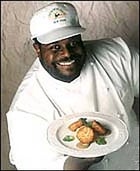
Tavern on the Green’s Patrick Clark whips up classic Americana with a dash of deception
Patrick Clark insists he didn’t turn down a chance in 1993 to become White House chef for fear of Bill Clinton shaking him at 3 a.m., demanding double chili-cheeseburgers. “No, it was quite flattering,” says Clark, who instead took the executive chef position at Tavern on the Green, the country’s top-grossing restaurant, located in Manhattan’s Central Park. Clark’s specialty is classic American cuisine prepared in a style that’s been described as “deceptively simple.” The 47-year-old Brooklyn native figures that the outdoors is where he got his start as a chef—”I was the only boy in my scout troop going for the cooking merit badge,” he notes—and he’s continued the tradition by cooking for his son’s scout troop. “Being outdoors means getting back to where food comes from,” he says. “There’s no need to get fancy, because meals just taste better outside.”
Breakfast: Country Style Eggs with Potatoes and Sausage
2 medium Idaho potatoes
1/2 lb. sausage, crumbled
2 small red onions, peeled and diced
12 large eggs
3 tbs. butter
Before leaving home: Bake the potatoes for 50 minutes at 350 degrees and then quarter, slice, and wrap in foil. Saut├ę the onions and sausage over medium-high heat. Drain, cool, and wrap in foil.
At camp: Melt butter in frying pan and saut├ę potatoes until golden brown. Add sausage and onion and then crack the eggs over the mixture. Stir occasionally. Add salt and pepper to taste.
With a full “hump day” ahead of you and, more than likely, a lot of activity in store, Clark figures a long, leisurely, fat- and protein-rich breakfast is just the thing. “If you were heading home later that day, I might advise a lighter meal,” Clark explains. “But with two more days of hiking to go, I’d take the time to fuel up.”
Lunch: Roasted Pork Sandwich with Mango Chutney Mayonnaise
1 cup mayonnaise
1 jar of mango chutney
12 limes
1 pork tenderloin, roasted
1 loaf sourdough bread
1 red onion
3 tbs. extra virgin olive oil
4 to 6 leaves of romaine lettuce
Before leaving home: Slice the onion into quarter-inch round sections, place on a baking sheet, drizzle with olive oil, and roast in a 350-degree oven until soft but not brown. Wrap in foil. Combine chutney, mayonnaise, and the juice of 12 limes in a bowl and mix well. Keep on ice until you reach the trailhead.
At camp: Slice bread and spread with the chutney mayonnaise. Carve off enough pork for each portion, place on bread, top with onion and lettuce, and “close” with a second slice of bread.
“Sandwiches are really easy when you’re out on the trail,” explains Clark. “You don’t have to cook anything–all you have to do out there is assemble.”
Dinner: Grilled Barbecue Marinated Flank Steak, Fire Roasted Potatoes, Onions with Spicy Butter, and Foil Baked Plantains with Vanilla
For the steak 1-1/2 cup cilantro (leaves and stems)
2 tsp. ground cumin
2 tsp. dried oregano
2 tsp. fresh thyme
1/2 onion, chopped
1/4 cup coarsely chopped garlic
1/2 cup vegetable oil
2 lb. flank steak
6 cloves garlic
3 bay leaves
2-1/2 jalape├▒o peppers, coarsely chopped, with seeds
1/4 cup chopped oregano leaves
1/3 cup brown sugar
1/3 cup rice wine vinegar
1/4 cup Dijon mustard
1 cup ketchup
Before leaving home: Two days before departure, combine cilantro, cumin, dried oregano, thyme, onion, garlic, and vegetable oil in a glass bowl. Add flank steak, cover, and refrigerate for 12 to 24 hours. Then stack the steaks in one slab and freeze until hard. When ready to leave, double-bag in plastic and place in a brown paper bag insulated with crushed egg cartons and newspapers. Keep on ice until you reach the trailhead.
To prepare the barbecue sauce: mash garlic, bay leaves, jalape├▒os, oregano leaves, and salt with a mortar and pestle until a paste is formed (or puree with a splash of vinegar in a blender). Transfer to a bowl and stir in vinegar, ketchup, brown sugar, and mustard. Store in a plastic container in the refrigerator until ready to leave; then transfer to a Nalgene bottle.
At camp: Season steak with salt and pepper. Place on preheated grill. Baste with the sauce on both sides. Grill to desired doneness. Slice flank steak against the grain.
For the potatoes and onions
16 new potatoes
32 pearl onions, peeled
4 tbs. olive oil
1 lb. unsalted butter
2 sprigs thyme, chopped
2 sprigs rosemary, chopped
2 tbs. black pepper, crushed
1 tsp. coriander seed, crushed
1 tsp. hot sauce
1/2 tsp. cayenne pepper
1 bunch flat-leaf parsley, chopped (no stems)
Before leaving home: Place all ingredients except potatoes, onions, and olive oil in a food processor and puree. Adjust seasoning to taste. Place in the middle of a square of foil or wax paper. Roll-wrap into log shape and then refrigerate. Transfer into Nalgene container just before leaving.
At camp: Make four potato-and-onion foil packages—four potatoes and eight onions in each, drizzled with one tablespoon of olive oil. Place packages on preheated grill and cook for 30 to 40 minutes, turning every ten minutes. Remove foil, group on a plate with the flank steak, and place a quarter-inch disk of the spicy butter concoction on top. For the plantains
4 semiripe plantains
1/4 cup brown sugar
1 tbs. soft butter
1/8 tsp. nutmeg
1 tbs. dark rum
1 vanilla bean, split in quarters
mint, julienned
Before leaving home: Combine sugar, butter, nutmeg, and rum to make a paste. Store in refrigerator until just before departure, and then transfer to a Nalgene bottle.
At camp: With a paring knife, cut a seam down each plantain. Insert a vanilla bean quarter in each and seal with sugar-butter paste. Wrap in foil. Place in coals for 20 minutes or until tender and remove. Carefully peel plantain, saving any sauce. Slice and serve on a plate, drizzling sauce on top. Garnish with mint.
As Clark points out, this meal allows you to deceive your campmates by doing the hard stuff at home and then dazzling them around the fire, leaving the impression that you whipped it up on the spot. “At the end of a long day, you don’t want dinner to be an arduous task.”
Day Three: World Beat on a WhisperLite
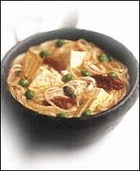
Mark Miller, impresario of fare from Southwestern to Asian, offers one-pot solutions for the peripatetic palate
Spice packs, it seems, are extremely personal items. Southwestern cuisine authority Mark Miller calls his a “gourmet emergency kit,” and he never leaves on a trek without it. Whether he’s crossing the Sahara by camel to collect Bedouin bread-baking tips or hiking in the Bolivian Andes to learn secrets about corn, the hyperkinetic chef packs six airline liquor bottles with his culinary necessities: basil oil, porcini oil, hot sauce, olive oil, black pepper, and garlic cloves. “You can do almost anything with that stuff,” insists the 47-year-old Santa Fe resident. This sense of eclectic scavenging permeates the inventive dishes Miller concocts at his world-famous Coyote Caf├ę restaurants (Austin, Las Vegas, and Santa Fe) and Red Sage (Washington, D.C.). The menu at Raku, his new eatery in the nation’s capital, boasts a similarly wide-ranging menu of “pan-Asian cuisine,” based on the street foods of Japan, China, Thailand, and Korea. For Miller, it’s obvious that adventurous cuisine and adventurous travel go hand in hand. “You have to be creative with your immediate environment,” he insists. “And if you’re camping, you have to use what nature gives you.”
Breakfast: Corn Cakes with Bourbon Syrup
3/4 cup flour
1/2 cup coarse cornmeal (polenta)
1/2 tsp. baking powder
1/2 tsp. baking soda
1 tsp. salt
1 tsp. sugar
1-1/4 cup evaporated milk
1 egg
1 cup fresh corn kernels
2 tbs. butter
12 oz. dark brown sugar
1 cup water
3/4 cup roasted pecans
1/3 cup bourbon
Before leaving home: Combine flour, cornmeal, baking powder, baking soda, salt, and sugar and store in a Nalgene bottle. Puree a half-cup of the corn and store separately.
At camp: In a large bowl, combine evaporated milk and egg and then stir in dry-ingredient mixture until thoroughly incorporated. Fold in pureed corn and remaining whole kernels. Melt butter in your skillet and add batter to form three-inch cakes. Cook until golden brown.
Meanwhile, in your pot, bring brown sugar and water to a boil and stir until all the sugar is dissolved. Continue to boil, without stirring, until the syrup thickens slightly. Mix in pecans and bourbon and then pour over corn cakes as desired.
Snack: Venison Jerky
3 lb. boneless venison
1/2 cup red chile flakes, coarsely ground
1/2 cup brown sugar
1/4 cup freshly ground black pepper
2 tbs. salt
2 tbs. juniper berries, coarsely ground (optional)
Before leaving home: Briefly freeze the venison so that it becomes somewhat firm; then cut the meat into thin slices. Mix the remaining ingredients together and rub them on the venison. Place the slices of meat on oven racks and slowly dehydrate in an oven set at its lowest temperature (100 to 150 degrees). This process should take at least eight hours and may take up to 12. Store in resealable plastic bags.
For the venison, check with a local butcher (some carry it during deer hunting season in the fall and winter) or a gourmet specialty store. You can also substitute a top round cut of beef for the venison.
Lunch: Tom Yum Noodles
4 packages Thai Kitchen Tom Yum Noodles or 16 oz. dried, flat rice noodles and 2 tbs. Tom Yum seasoning in jar
2 oz. sun-dried tomatoes, sliced into large pieces
2-3 serrano chiles or 2-3 Thai chiles
4 one-inch pieces of fresh lemongrass
1 oz. dried peas
10-1/4 oz. Mori-Nu Soft Tofu, shelf stable, nonrefrigerated, cut into one-inch squares
2 cloves fresh garlic
At camp: Fill a three-quart saucepan with eight cups of water and add the sun-dried tomatoes. Place over heat. While waiting for water to boil, slice chiles and garlic thinly. Smash the fresh lemongrass with a flat rock. Add the lemongrass, dried peas, noodles, and chiles to the water. Boil for five minutes. Add cubes of soft tofu.
Dinner: Southwest Paella
3 tbs. extra virgin olive oil
1 small white onion, chopped into large pieces
6 cloves fresh garlic, finely chopped
2 large jalape├▒os, sliced into rings
6 oz. white albacore tuna, packed in water or olive oil, drained
6-7 oz. can whole clams or shrimp
1 oz. sun-dried tomatoes, nonsalted
3/4 cup whole roasted red peppers, rinsed and cut into large pieces
3/4 cup black olives, oil-cured
6 oz. box Texmati Chefs Original Smoky Cowboy Beans and Rice
4 oz. dried spicy sausage (e.g., pepperoni), cut into 1/4-inch rounds (optional)
1 oz. dried peas (optional)
At camp: Add two tablespoons of olive oil to your skillet. Add chopped onions, garlic, and jalape├▒os. Cook over low heat for 15 to 20 minutes, until the onions are fully cooked and soft. Add two cups of water, rice-and-seasoning mixture, and liquid from the canned clams or shrimp. Cover and cook over low heat for approximately ten minutes. Add the peas, olives, peppers, sausage rounds, and the clams or shrimp. Cook five minutes longer, covered, and then top with tuna and the last tablespoon of olive oil.
Miller’s rationale for both the lunch and dinner choices is simple: energy. “The pasta and the rice are high in carbohydrates,” he explains. “And that’s what you’ll need on the trail to keep going both in the afternoon and during your hike out the next morning.”


